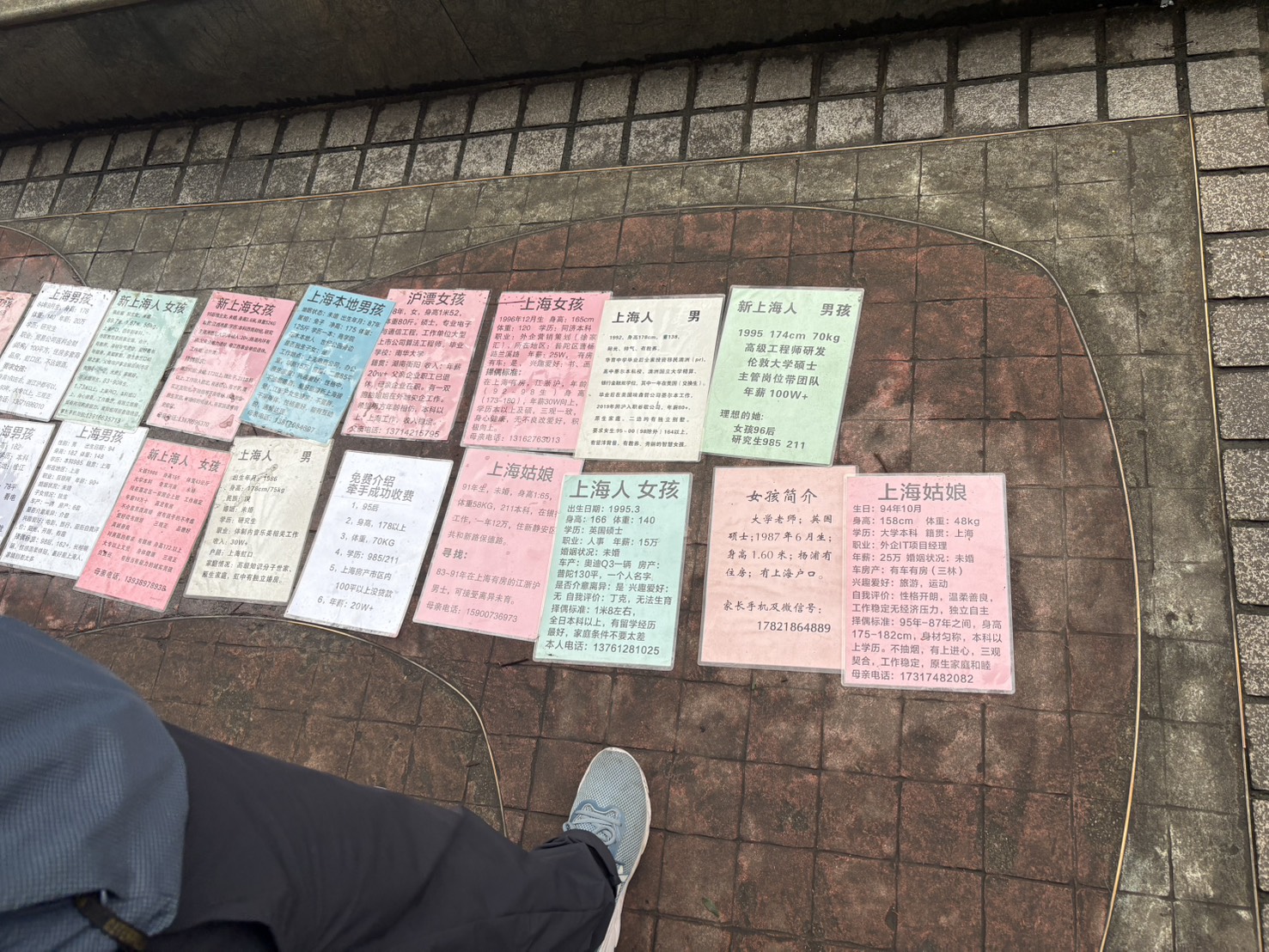中國奇特的公園相親文化
在中國的大城市,尤其是像上海這樣的一線城市,公園相親角已經成為一種獨特的社會現象。每逢週末,人民公園、魯迅公園等場所總能看到許多父母帶著子女的個人資料,熱絡地交流資訊,試圖為孩子尋覓合適的伴侶。這種現象的興起,背後反映當代中國社會的深層結構與文化心理,而其成功率與優缺點也值得深入探討。
這種相親模式的出現,首先與中國傳統的家庭觀念密切相關。在華人文化中,婚姻歷來被視為「終身大事」,不僅關乎個人幸福,更承載著家族延續的責任。父母介入子女的婚戀,在某種程度上是傳統「父母之命」的現代變體。尤其在計劃生育政策下成長的獨生子女一代,父母往往更迫切地希望參與子女的人生規劃,而婚姻則是其中最重要的環節之一。這種代際間的緊密聯繫,使得父母在子女的婚戀中扮演積極的角色。
其次,現代都市生活的快節奏與高壓力,也促成公園相親角的盛行。在大城市中,許多年輕人忙於工作,社交圈狹窄,難以通過自然交往認識合適的對象。相親角提供一個高效率的篩選平台,父母們可以在短時間內接觸大量潛在的候選人,並根據學歷、收入、房產等硬性條件進行初步匹配。這種方式在某種程度上適應都市人追求效率的心理,尤其對那些工作繁忙、社交時間有限的年輕人而言,父母的代勞成現實的選擇。
然而,這種相親模式的實際成功率卻並不高。許多研究與報導指出,公園相親角雖然人氣旺盛,但真正能通過這種方式步入婚姻的情侶並不多見。這主要是因為婚姻的締結不僅依賴於外在條件的匹配,更需雙方在性格、價值觀、生活方式等軟性因素上的契合。父母代為篩選時,往往過於注重物質條件,而忽略了情感層面的相容性。此外,年輕一代對這種帶有強制色彩的相親方式也常抱有抵觸心理,許多人參與只是為安撫父母,而非真正認同這種模式。
公園相親角的優點在於其直接與高效。它將婚戀市場的供需雙方集中在一個物理空間,避免網絡相親的虛假資訊問題,也節省個人逐一篩選的時間成本。對一些社交能力較弱或工作環境封閉的人來說,這種方式提供額外的機會。同時,父母的把關也能在一定程度上降低婚戀風險,尤其是在財產與家庭背景的核實上,長輩的經驗往往更具實用性。
但這種模式的缺點也顯而易見。過度強調物質條件(如房產、戶口、收入)的匹配,容易將婚姻異化為一場交易,削弱情感連結的重要性。許多相親資料上羅列的條件,宛如一份冰冷的履歷,缺乏對個人特質與生活態度的呈現。此外,代際間的擇偶標準差異也常導致矛盾——父母看重的是穩定性與社會地位,而年輕人可能更在意情感共鳴與生活樂趣。這種價值觀的衝突,使得許多通過相親角認識的關係難以深入發展。
更深層次來看,公園相親角的盛行也折射出中國社會轉型期的矛盾。一方面,都市化與現代化催生個人主義的覺醒,年輕人越來越重視婚姻中的自主選擇;另一方面,傳統的家庭觀念與現實的生存壓力又讓父母不得不介入子女的婚戀決策。這種張力使得相親角既成為代際合作的場域,也成為觀念碰撞的焦點。
總的來說,公園相親角是中國特色社會環境下的產物,體現傳統與現代、個人與家庭、情感與現實之間的複雜互動。雖然其實際成功率有限,但作為一種社會現象,它為觀察中國人的婚戀觀念與家庭關係提供獨特的視窗。未來,隨著年輕一代話語權的增強與社會觀念的進步開放,這種模式或許會逐步演變,但其背後的文化邏輯與社會需求,仍將在很長一段時間內持續影響中國人的婚戀行為。
In major Chinese cities—especially in first-tier metropolises like Shanghai—“marriage markets” in public parks have become a distinctive social phenomenon. On weekends, places like People’s Park and Lu Xun Park are filled with parents exchanging their children’s personal information in hopes of finding a suitable partner for them. This trend reflects deeper structural and cultural dynamics within contemporary Chinese society, and its success rate, as well as its pros and cons, merit closer examination.
The Cultural Roots: Traditional Family Values
This matchmaking model is closely tied to traditional Chinese family values. In Chinese culture, marriage has long been viewed as a major life event, not just for the individual’s happiness, but also as a responsibility to continue the family line. Parental involvement in their children's romantic lives is, in some ways, a modern extension of the age-old concept of arranged marriage. This is particularly true for the generation of only children raised under the one-child policy, where parents often feel an intense urge to be involved in life decisions—especially marriage, which they see as one of the most critical milestones. This close intergenerational bond positions parents as active participants in their children's relationships.
Urban Pressures and the Rise of Park Matchmaking
The fast pace and high pressure of modern urban life have also contributed to the popularity of these matchmaking corners. Many young people in big cities are consumed by work, have limited social circles, and find it difficult to meet suitable partners organically. Marriage markets offer an efficient, high-volume screening platform where parents can quickly connect with numerous potential matches based on tangible criteria such as education, income, and property ownership. This system aligns with the urban mindset that often prioritizes efficiency, and for busy young professionals, parental involvement becomes a practical workaround to time and energy constraints.
Low Success Rates and Underlying Limitations
Despite their popularity, these matchmaking corners have a relatively low success rate. Studies and reports indicate that few couples actually marry through this channel. One key reason is that successful relationships depend on more than just material compatibility; personality, values, and lifestyle compatibility are equally, if not more, important. Parents often overemphasize material factors and overlook emotional resonance. Moreover, many young people view this process as overbearing or outdated, participating only to appease their parents rather than out of genuine interest. This lack of agency weakens the effectiveness of the approach.
Strengths: Directness and Efficiency
The strength of the park matchmaking model lies in its direct and efficient nature. It physically gathers both sides of the marriage market in one location, avoiding the risk of false information common in online dating, and saving individuals from the time-consuming task of screening candidates one by one. For those with limited social skills or closed-off work environments, it offers valuable opportunities. Parental involvement can also serve as a form of risk mitigation, particularly in verifying financial and familial backgrounds, where older generations often have sharper instincts and experience.
Weaknesses: Transactional Tendencies and Value Conflicts
However, the downsides are equally apparent. The overemphasis on material qualifications—such as property ownership, household registration, and income—can reduce marriage to a transactional arrangement, sidelining emotional bonds. Many matchmaking profiles resemble clinical résumés, offering little insight into personal character or values. Furthermore, intergenerational differences in partner criteria often create tension: parents tend to value stability and social status, whereas younger people may prioritize emotional connection and shared lifestyle values. These value conflicts often prevent relationships formed this way from progressing meaningfully.
A Mirror of Transitional China
On a deeper level, the prevalence of matchmaking corners reflects China’s transitional social landscape. On one hand, urbanization and modernization have led to a growing sense of individualism, with younger generations emphasizing personal choice in marriage. On the other hand, traditional family values and real-world pressures push parents to intervene in these decisions. This creates a tension that turns the matchmaking corner into both a site of cooperation and a battleground of ideologies between generations.
Conclusion: A Cultural Snapshot in Flux
In sum, park matchmaking corners are a unique product of China’s socio-cultural environment, embodying the complex interplay between tradition and modernity, individual and family, emotion and pragmatism. While their actual success rate may be limited, they offer a valuable lens for understanding Chinese attitudes toward marriage and family. In the future, as younger generations gain more autonomy and social norms continue to evolve, this model may gradually transform. Yet, the cultural logic and social needs underpinning it are likely to continue shaping romantic behaviors in China for years to come.

- 1
- 2
- 3
- 4
